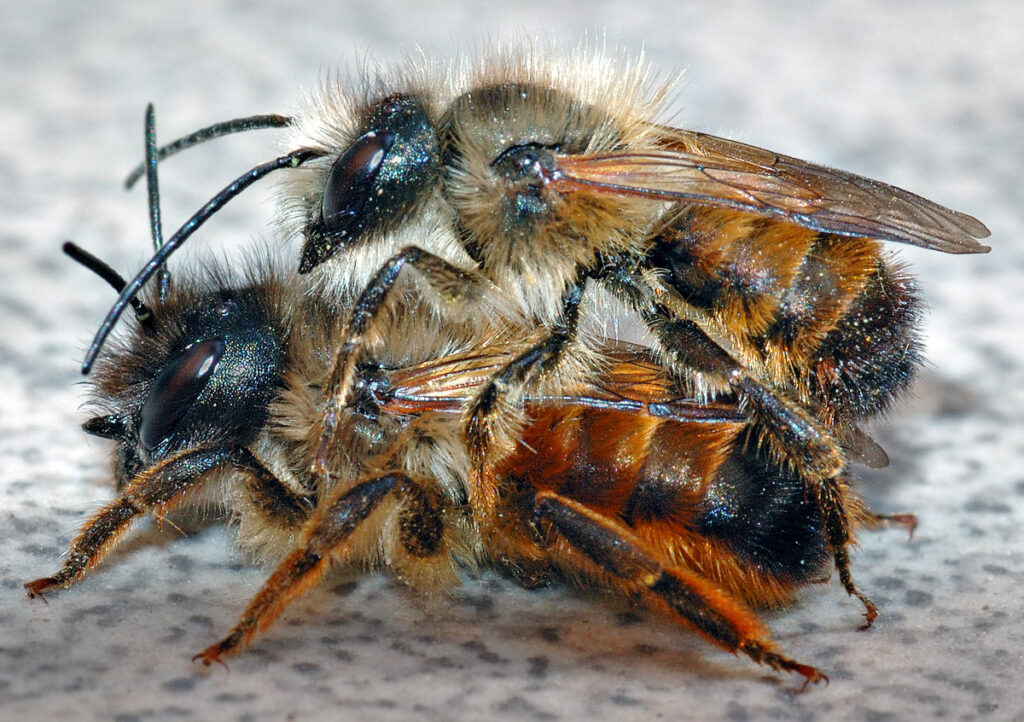Do you know this busy bee? It has been named Insect of the Year 2019. In fruit growing, the pollinating power of the rusty red mason bee is used commercially, because they can pollinate more than 2500 flowers a day. Now they are also available for home gardens.
We are aware of the dramatic worldwide decline of many insect species and therefore support them in the garden with sufficient nectar- and pollen-rich plants, habitats as well as nesting aids as nurseries. Some companies now even offer nesting aids with starter cultures for mason bees. Does that make sense? Can’t we do without? Read more below in the interview with Dr. Christian Schmid-Egger from the European Wildlife Foundation (pollinator-friendly city project, Berlin).
The rusty red mason bee
Contents
There are about 20,000 species of wild bees worldwide, 9 of which are honey bees.
The rusty mason bee (Osmia bicornis) is a very good pollinator because it collects pollen dry in its abdominal brush. Almost every one of its flower visits, 98 percent, results in pollination. In contrast, honey bees have to fly to an average of five apple blossoms to pollinate a single one, because they transport the pollen mixed with nectar on their legs. One female of the rusty mason bee pollinates between 80 and 300 honey bees, which is why they are popular and hard-working helpers in commercial fruit growing.
Occurrence and mating
The rusty mason bee is active from the beginning of April and is an ideal pollinator for late stone fruit, pome fruit and strawberries. It is one of the most abundant species and is extremely adaptable. It occurs in the north from cool southern Sweden to hot northern Africa. The males hatch before the females and usually have to wait patiently for a few days until the first females show themselves. The female bees deliberately choose a male to mate with. To win over the females, the males sometimes use scents and their long antennae during their courtship dance. The scents can also provide information about the regional origin. The mating of the rusty red mason bees lasts up to two hours. After that, the two do not see each other again.
Brood business
The females of the rusty mason bee then begin their breeding business and are more flexible than any other bee species when it comes to finding their nurseries. They nest in cavities of all kinds: old boreholes in wood, hollow stems, cracks, holes in mud walls and brickwork or even in the keyhole of a shed. A female needs several hours to build a brood cell with an egg, a collected pollen-nectar supply and a partition wall made of clay mixed with saliva.
In tubular cavities with a diameter of six to nine millimetres, a female builds a total of 20 to 30 brood cells. The rusty mason bee can determine the sex of its offspring itself. Fertilised eggs become females, unfertilised eggs become males. Because the smaller males hatch two to three days before the females, mason bees lay the male eggs in the front brood cells. In this way they avoid congestion during hatching.
There are 2000 species in Europe. Almost one in ten wild bee species is threatened with extinction.
PROFILE of the rusty mason bee
- Latin name: Osmia bicornis
- Animal group: Insect
- Flight period: early April to mid-June
- Occurrence: widespread where there are flowers and nesting sites
- Nesting sites: hollow stems, holes in mud walls and brickwork
- Size: 10-12 mm
- Colour: fur reddish brown
- Talent: pollinator professional as a belly-gatherer bee
- Speed: up to eight metres per second
- Age: usually one year in the nest and then four to six weeks flying time
- Development: from egg to larva, from pupa to finished bee
- Food of: Pollen and nectar from a total of 18 plant families (unspecialised)
What do you think of the starter cultures for mason bees that have recently been shipped in the trade?
I consider the shipment of starter cultures of the two mason bee species to be ecologically highly problematic. The rusty red mason bee (Osmia bicornis) is very widespread and common throughout Europe, the horned mason bee (Osmia cornuta) in southern Europe. It is therefore not necessary to introduce animals, but rather to support the already existing populations, especially with nesting aids and flowering plants in one’s own garden. Such measures also promote many other wild bee species, some of which are much rarer or more endangered than the two mason bee species.
Where do you see the main problem?
Wild bees are also attacked by a number of parasites and microorganisms. Some of them also have the potential to cause diseases. If these species are shipped throughout Europe or Europe, there is a risk of spreading these diseases and endangering the original populations of these bees quite unnecessarily. However, the subject is still insufficiently researched. For this reason, too, we should refrain from shipping these bees on the basis of the precautionary principle.
How can the introduction of foreign populations be harmful?
As a rule, there are about as many wild bee individuals in a biotope that the nesting and food resources are sufficient for the animals. Introducing large numbers of mason bees from outside the biotope increases the pressure on existing populations and upsets the usually carefully balanced equilibrium. In addition, the imported mason bees will also occupy other and, above all, natural nesting sites outside the purchased nesting aid. However, these are needed by species that fly later in the year and are much rarer, such as leafcutter bees. Thus, there is a risk that purchased wild bees may even harm the existing wild bee populations and thus further promote species extinction.
Source: https://en.wikipedia.org/wiki/Mason_bee


